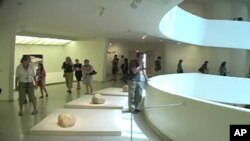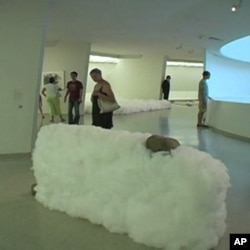One of America's most prestigious museums of modern and contemporary art is showcasing the work of Korean artist Lee Ufan.
Born in Korea, the 75-year-old has lived and taught in Japan, where he enjoys the respect of several post-war generations of intellectuals for his role in leading philosophical and artistic movements countering westernization.
New York’s Guggenheim Museum provides a unique backdrop for Ufan, because the museum’s continuous spiral ramp underlines infinity; a pivotal notion in his work.
“Marking Infinity,” Lee Ufan’s first retrospective in an American museum, gathers 70 paintings, sculptures and drawings. They fill the Guggenheim’s Rotunda floor and its six ramps - the late-period gem of architect Frank Lloyd Wright.
Ufan installed the retrospective himself during a three-week residency, uniting examples of five decades of his art into one continuous statement.
“For Lee Ufan, collaborating with the Rotunda space at the Guggenheim Museum has been an enormous leap forward for his own understanding of his own work," says Alexandra Munroe, the museum’s senior curator of Asian Art. "And he realizes that in essence, what the Guggenheim Museum is all about, which is the awareness of the body in space, is about many of the same ideas."
Ufan grew up through several wars and experienced the assault of modern culture, which interrupted ancient philosophical systems.
“What is at the essence of his art is uncertainty and things that are not fixed and things that are open and scattered, and open to our interpretation and open to our experience and infinite," Munroe says. "The title of this exhibition is ‘Marking Infinity.’ Infinity is the opposite of finite, is the opposite of what is fixed. He is asking us to imagine a world where there is a coexistence between man and what he calls the other, man and nature, now and the past.”
In his installations, opposites coexist, as in sculptures where heavy rocks and steel are held impossibly in the air by clouds of cotton.
“And there is another very important idea that you see both in his sculpture and his paintings, which I call the ‘ethic of restraint,’" says Munroe. "He’s interested in the relationship between making and non-making - what he calls non-making."
Ufan tries to separate us from our backgrounds, histories, mythologies and psychological concerns. Devoid of narrative, his art belongs to the school of here and now.
















